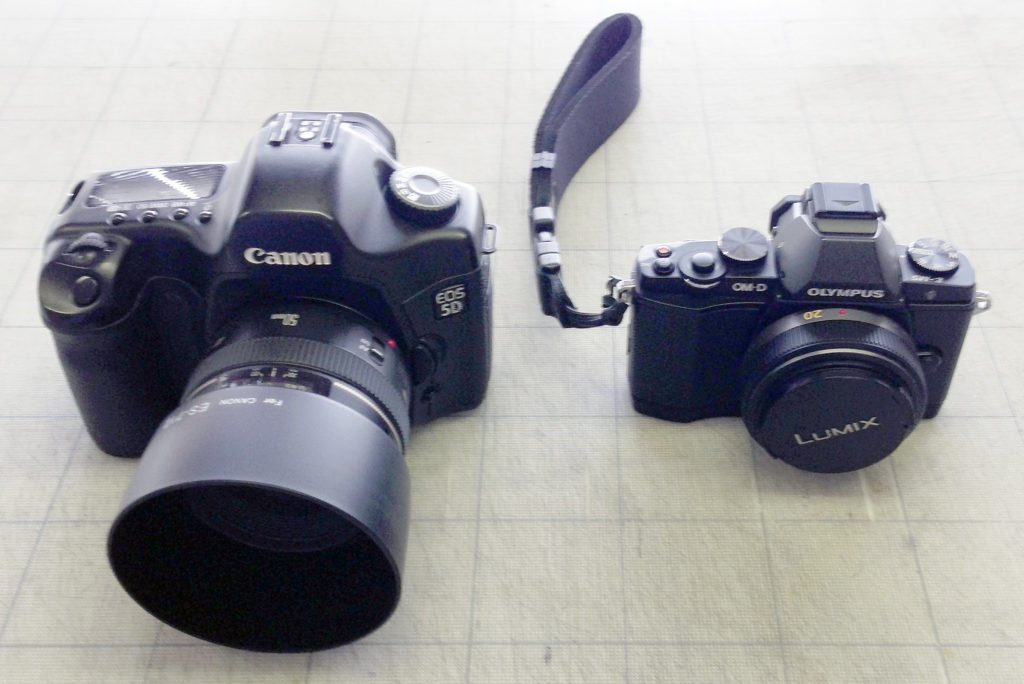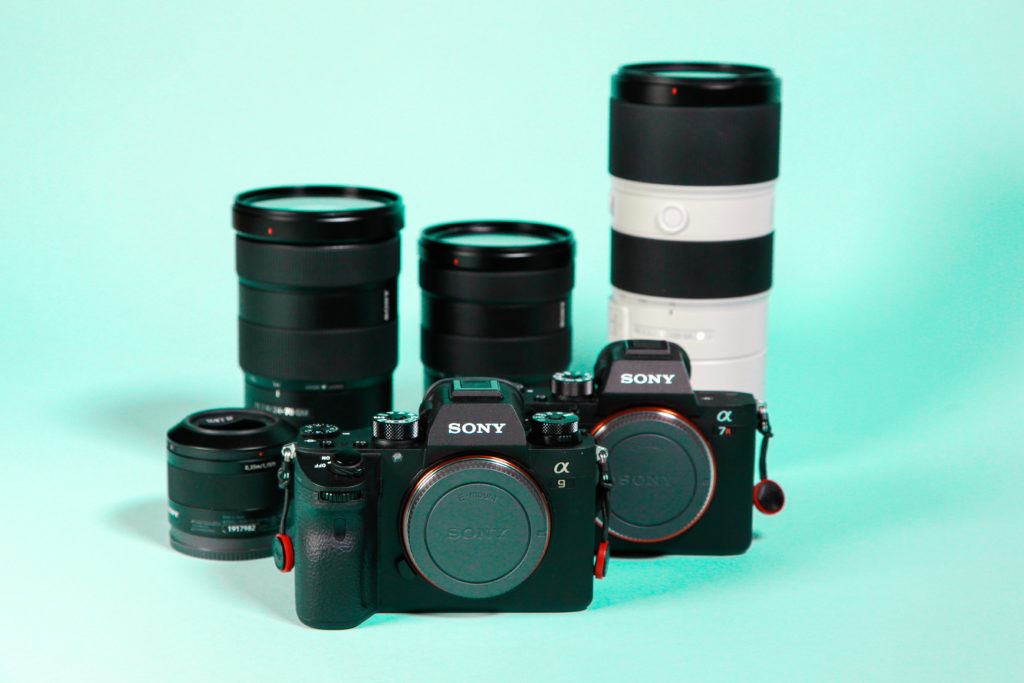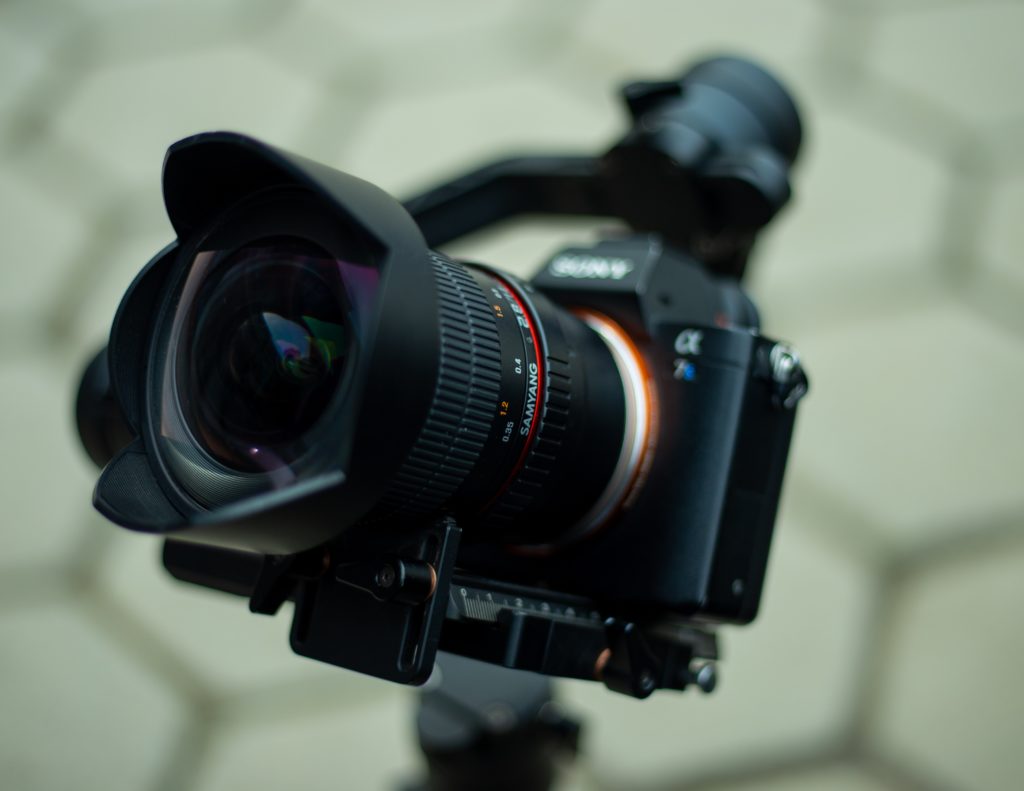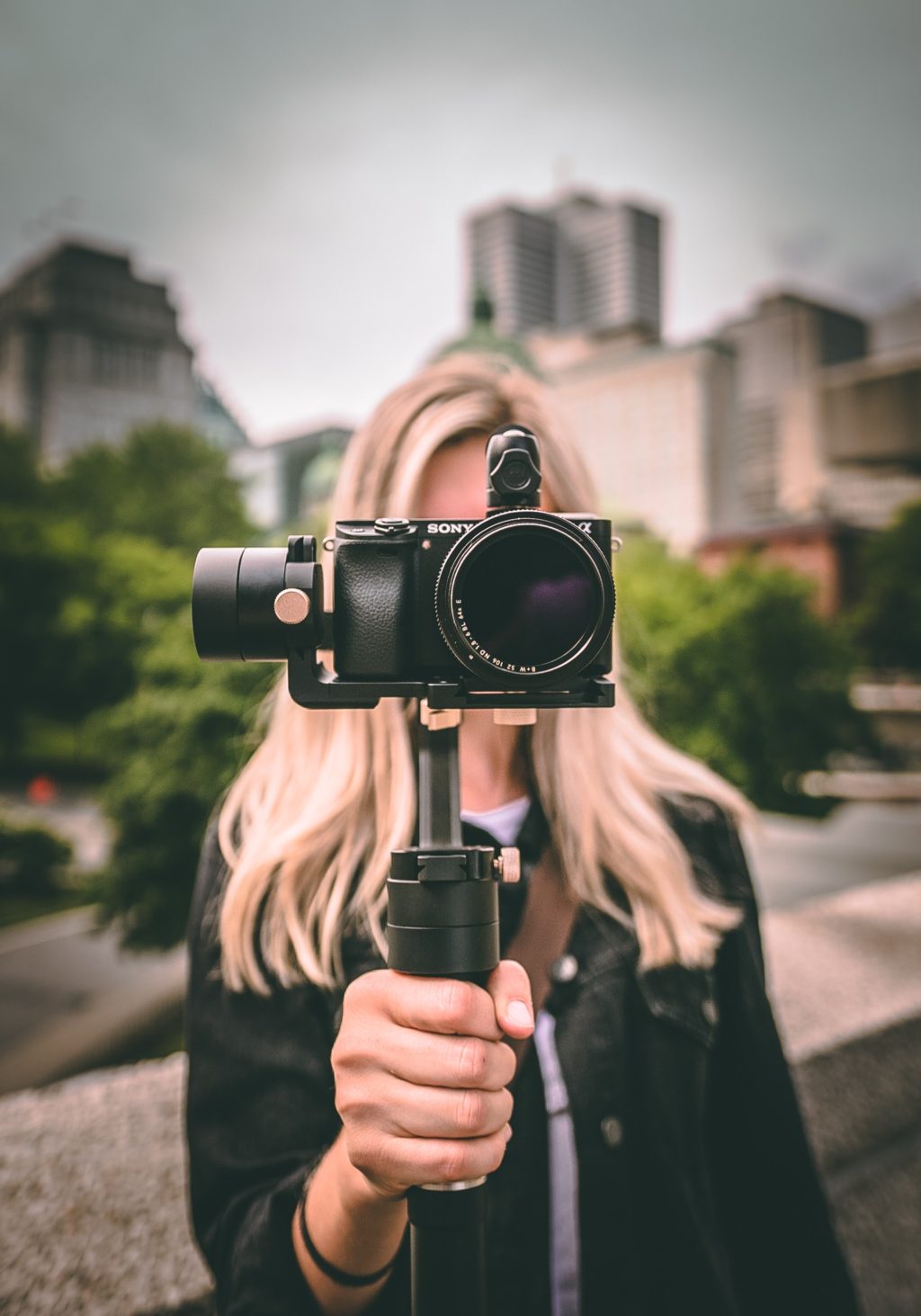Anyone who has been involved in photography long enough should be familiar with the sometimes contentious debate about the differences, whether real or imagined, between film and digital. Which exhibits better dynamic range? Which has better resolution? How much better? The digital medium has established itself as the imaging standard, and most who still engage in the film versus digital discussion are generally content to concede that both can co-exist.
Arguments over the merits of film photography as compared to digital photography have died down as technology has continued to advance, but it is this ever-advancing technology that is responsible for the persistence of still another topic of debate within the photography world: DSLR versus mirrorless.
Are DSLRs, with their bulky bodies and slapping mirrors, really dinosaurs? Are mirrorless cameras truly the future of photography? These questions don’t have simple “yes” or “no” answers, and that is a good thing for everyone. But if you find yourself in a position of having to choose between the two technologies, here are a few key factors to keep in mind.
Size and Weight
Digital SLR cameras are bigger, bulkier and heavier than their mirrorless counterparts, as they need to house a mirror and prism mechanism.
Mirrorless cameras obviously lack a mirror; nothing sits between the rear element of the lens and the imaging sensor. This design helps cut down size and weight significantly. However, if there is an upside to the more robust DSLR bodies, it is better ergonomics.

Viewfinder
DSLRs employ an optical viewfinder as their primary means of previewing an image. When you look through an optical viewfinder, you are looking at the exact scene the camera will capture when you press the shutter button.
Mirrorless cameras use an LCD screen or an electronic viewfinder (EVF) to preview images. The EVF essentially provides real-time electronic rendering of what you would see through an optical viewfinder. While mirrorless cameras such as the Fujifilm X-T3, X-H1 or GFX series, Olympus’ OMD series, or Sony’s A7 and A9 lineup, Nikon's Z series, feature very good EVFs with minimal lag and blackout where you will experience the feel and responsiveness of an optical viewfinder, but the technology overall is continuing to improve. Electronic viewfinders have yet to edge out optical viewfinders for many photographers, while others are perfectly content with their EVF.
Autofocus
When it comes to autofocus speed, DSLRs have traditionally enjoyed bragging rights. However, various mirrorless releases from the likes of Sony (a6500, A7 series, A9), Panasonic (GX9, GH5), Olympus (OM-D E-M1X, OM-D E-M1 MARK II) , Nikon (Z6, Z7), Canon (EOS R) and Fujifilm (X-T2, X-H1, GFX series) each have at some point made pretty bold claims about AF speed.
“Real-world” testings have proved that some mirrorless cameras performed exceptionally well in comparison to the high-end DSLRs. Even sports and wildlife photographers have started using mirrorless cameras as evidenced here on the job. This is due, in part, to the implementation of hybrid autofocus — an AF system that combines both phase detection and contrast detection technologies.

Lens Selection
Given that DSLRs have been the dominant format for so long, it makes sense that there is such a comprehensive selection of lenses — both native and third party — available for these cameras. Mirrorless cameras, for example, Sony, have a comparatively small (but growing) stable of native lenses available and third party lenses are becoming more available in the market compared to a few years before, for Sony mirrorless cameras.
The main exception to this, of course, is the Micro Four Thirds mirrorless format that have more than 70 native lenses available, the bulk of which are manufactured by Olympus and Panasonic (the companies behind the Micro Four Thirds format). Lenses from third-party manufacturers like Sigma, Tamron, and Rokinon/Samyang have helped fill in gaps left by the lack of native mirrorless lenses. Mirrorless cameras are also easily adapted to fit virtually any manual focus legacy lens.

Image Quality
Due to their larger sensors (APS-C or full-frame) DSLRs were at one time considered the clear winners when it comes to image quality. But today, even the small Micro Four Thirds size sensor has advanced to the point that overall image quality leaves little to be desired for mirrorless camera users. Upping the ante, even more, is the incorporation of APS-C size sensors (standard in most Fujifilm X cameras, Sony A6000 series), full-frame sensors (Sony’s A7 series and A9, Nikon's Z series, Canon) and medium format sensors (Fujifilm GFX series) in mirrorless bodies.

Video
The ability to shoot video is a standard feature on any camera these days. Mirrorless cameras tend to be a better option for those looking for fast and accurate focusing/tracking in video mode (mirrorless cameras are sometimes spoken of as video cameras with the ability to do still shots). Comparatively few DSLRs are equipped with the means — namely, on-sensor phase-detection points — to challenge mirrorless systems in this area. Furthermore, while both mirrorless and DSLRs are capable of broadcast quality/HD video, newer 4K/Ultra HD is currently far more likely to be found in mirrorless bodies. Canon’s 1D C, released in 2013, became the first DSLR to incorporate 4K resolution.

The Bottom Line
The items above aren’t the entirety of all the things one might take into account when deciding between a mirrorless or DSLR camera; if battery life, for example, is a particularly important factor for you, then you might be happier with a DSLR (or stock up on extra batteries if you prefer a mirrorless body). Everything in photography is indeed a compromise. But all the options generated by all the competition is good for consumers. The debate over which technology is “better” is mostly pointless. Make your decision based on which camera offers features that are best suited to your style of shooting. That is all there is to it, really.





43 Comments
Thank you. I think you have covered everything, clearly and elegantly.
A few weeks ago I bought a Fujifilm X Pro1. It sits happily in a jacket pocket with a spare lens or two in the other pocket. Picture quality is better than my beloved Pentax K5. My pain-free back is overjoyed.
Christopher Wright
Not everything
One big plus of having an EVF is that it allows you to zoom in and focus manually with high precision
Concur with Wright’s observation.
But one are that required clarity was regarding the availability and adaptability of CPL, UV and Warm filters in tandem with the lenses of MILC. Will someone clarify.
Great forum
Divakaran Prem Nath
Nice article that answered most of my questions in considering a mirrorless. I continue to worry about low-light performance in terms of both noise at higher ISO’s and auto-focus performance under dim conditions. There are clear advantages of a mirrorless over a DSLR for street photography, but how does it match up to a full-frame DSLR at night (or in a music club)?
I am a happy Sony A7 shooter. It’s a full frame mirrorless that performs beautifully in low light (though the Sony A7s performs even better) in terms of getting clean/noise-free images. Autofocus does sometimes struggle, but I’ve grown accustomed to manual focusing in those situations, and it’s nice to have focus peaking to help you out. I’ve never done a direct comparison with a DSLR, but using a 55mm f/1.8 lens on the A7 leaves little to complain about and doesn’t seem to be any worse than what I experienced using a Canon 6D in similar situations.
Thanks Jason. I am just starting to look. I will still keep my D800 for studio work, but would love something lighter and less conspicuous for street, travel and concert photography.
Absolutely.
enjoyed the article. Personally, I like having my Nikon DSLR and my mirrorless cameras. Both come in handy in different situations. The Nikon when shooting portraits, and my Fuji mirrorless when I don’t want to lug around a heavy DSLR. And even though AF in mirrorless cameras are getting faster, they’re still no match for a DSLR.
I think yiou have to decide in which situations you use mirrorless or dslrs. For action photography trying to get a moving object using a view finder with the sun shining on it could prove a challenge . For things like travel , landscapes a mirrorless would be ok.
I haven’t read about how good mirrorless images are for printing. Even with a high-end DLSR, images that look good on the web may not stand the test of even a medium-sized print (12×18)….I know…I’ve taken some.
That’s all to do with how well you edit the image, and the quality of the printing materials used. Shooting in RAW, and editing the contrast in lightroom to make sure everything is in gamut greatly improves print quality, and using a good printer with quality paper and ink means colour representation will be at its best. Printing good photos isn’t easy, being able to represent vibrant colours and high contrast on paper is even more difficult. The camera isn’t the problem when it comes to printing.
I just printed a 16×20 yesterday from a low-end Mirrorless camera and it looked fantastic (even though I had to crop off part of the left side of the photo to fit that print size) from a 20.3mp Sony. It’s all about the original image quality and the end result after editing.
DSLRs employ an optical viewfinder as their primary means of previewing an image. When you look through an optical viewfinder, you are looking at the exact scene the camera will capture when you press the shutter button. Mirrorless cameras use an LCD screen or an electronic viewfinder (EVF) to preview images. The EVF essentially provides a real-time electronic rendering of what you would see through an optical viewfinder. While mirrorless cameras such as the Fujifilm X-T1, Olympus’ OMD series, or Sony’s A7 lineup feature very good EVFs, the technology overall is continuing to improve. Electronic viewfinders have yet to edge out optical viewfinders for many photographers, while others are perfectly content with their EVF.
I don’t think that is accurate. I have both an Olympus E-3 (DSLR) and Olympus OMD EM1 (Mirrorless). Yes the E-3 shows me exactly what I will see, but the EM1 shows me exactly what photo I will take. The optical viewfinder does not show me what I will ‘capture’ though. If I have the settings wrong then it doesn’t show me that until after I have taken the photo. If I have the settings wrong in the EM1 then I see that through the viewfinder and can make adjustments – I can also see what small adjustments make to the final picture. I have found this to be a massive improvement – pplus the fact that I can zoom in on different parts of the picture, checking focus etc – which I can not do through the E-3 viewfinder. Seeing as I have deteriorating eye-sight this is a massive advantage that a DSLR can never do.
One of the areas of concern right from the film age to DSLRs, of not knowing what the final picture is till it is printed or reviewed digitally post snap gets salvation with the advent of the MILC.
The emergence of the certainty of the final picture, as seen through EVF in MILC, is a great leap forward as it enables one to see the final shape of what you capture. This I think is a substantial improvement in the field of photography as it enables real-time correction of exposure instead of post facto correction/retakes.
I’ve been shooting dslt for a few years now. I like to think of it as the best of both worlds. Makes me sad though that Sony seems to have given up on it. Regardless I am happy to shoot with anything that gets me the images I want to make!
Mirrorless cameras seem to have many advantages, but how easy is it to see the LCD in bright sunlight?
depends on the model really. The one I use (which is their low end model from Sony) isn’t all that difficult to see in direct Florida sunlight once you enable the “Daylight” setting in the display menu. Granted it could still be improved a bit, but it’s still not all that difficult when out and about honestly. Typically in bright sunlight I opt to use the EVF instead as it still allows the user to see a very, very close example as to what the finished capture will look like as you make changes to the settings. But that does not mean I am afraid to use the LCD, all depends on what and where I am shooting. If its on a tripod for HDR landscape photos or any form of long exposures, then I use the LCD during the daylight and EVF if shooting at night. If just walking around and not using a tripod or monopod, I like using the EVF better as you have better control of camera movement than holding it out a ways to see an LCD. At first I was a bit skeptical about buying one (which is the largest reason I bought their lower end model to control the possible amount of funding lost), but now I absolutely love it and looking forward to upgrading to a higher end model.
Hi Chris, what model did you write this comment about? I’m looking to get a mirrorless camera but I can’t decide if I really need the EVF or if I can save money with just getting the LCD. I do want to take photos of my kids’ sports, from basketball to rugby in bright sunlight. What is your opinion about being able to take clear pictures with just the LCD in sunlight on a rugby pitch?
Like Chris said above, the LCD of mirrorless cameras have option to “brighten” the screen. In my case with Fujifilm X-A2, it’s called Sunlight mode. It helps considerably BUT I still hope it can be better. In this sunlight mode, it would be difficult to adjust exposure due to the enhanced brightness of the screen.
I wish I chose the Fuji model with EVF like X-E2. But from searching the net, I found that there is something called “hoodloupe” that can give shade to LCD screen. I just ordered one from B&H. Should alleviate my problem somehow.
But the best thing is to buy mirrorless camera with EVF. Period.
So in MILC what you see in the EVF is “what you get . .” whereas in the DSLR it is the other way.
About lenses sizes I don’t agree the point, is something I would keep outside this comparison. Infact comparing sizes of full frame lenses with 4:3 lenses that collects much less light is just non-sense, look how much the Fuji 16-50 2.8 or the 18-55 2.8/4 are big and heavy, and also unbalanced with the camera!! For now mirrorless allow only to have lenses a bit shorter, and a bit simpler wide angle construction, not the difference shown in the article.
Also weight of cameras is a mith, just few grams less, I like mirrorless only for better viewfinder with almost live (there is a lag) preview, focus peaking and the ability for some models to do silent shoots, other things are just marketing.
Weight is a myth? Are you serious? Compare full frame to full frame models such as a Canon 5D mk3 to a Sony A7 model (any of them) and show me were it’s only “a few grams”. The difference is very clearly seen.
Chris here there’s an example the DSLR Nikon D750 it’s 750g and Sony A7S II is 627, only 123g less. Not so extraordinary!
Maybe I could aprecciate the difference between a Nikon D7200 and Fuji XT-1 where the Nikon is 200gr more (440 g vs 675 g), but then a good Fuji zoom will
If you want more portability I think Fuji is the way to go, infact the problem of DSLR here is that main brands are focused on Full Frame format and they produce good lenses only for FX, so bigger and heavier than a DX version of same lens.
I repeat what I said above, I believe the strongest point of mirrorlesses is the good viewfinder, beside the electronic lag and the more battery consumption, plenty of info, wide, reliable live preview and bright even when it’s dark.
The Pansonic GH4 has a really cool eye recognition feature
that gives precision eye focus. Have never been happier!
I have recently sold all my Nikon gear (D700). It was a sentimental day when I walked into my photographic retailer and traded it all for the Fuji X-T1. I had done a lot of research and realised a couple of things. 1. The end of the DSLR is coming. Like film there is a massive backlash against big bulky cameras. My local retailer used to sell 2-3 SLRs a day. Now he sells 2-3 every three weeks.
2. Fuji lens are outstanding quality and build. I am simply blown away at the images its allowing me to take. The retailer traded in 2 D700’s, a 1D and a D7000 yesterday – all for the X-T1. My suggestion to any reader that’s thinking of changing to mirror less – do it now! I’m predicting the market will flood and trade in prices will crash. An X-T1 with a couple of lenses will cost $2500 -$3000. Getting $2000 for my Nikon gear was good ( not great ), but I feel like I’ve fallen in love with photography again
Of course your dealer sells fewer DSLRs and more MSCs. Most of us already have one or more DSLRs that will do a good job for years to come, but we’d like a small, high-performing, pocketable camera as well. I would guess (but obviously do not know for sure) that people like you that make a complete change from one system to the other are the exceptions.
But it is a good thing for some. It means lots of excellent DSLR bodies and lenses on the second-hand market at bargain prices.
i shoot medium format film (Hasselblad, Diana, Lubitel) but digital is the way to go for street, events & parties. I’m on my second Olympus Pen. I use a great Panosonic prime pancake lens (lumix 20). The mirror less cameras are small enough to carry everywhere! Plus the photos are great.
About the Camerastore action test, its basically a simple test on a predictable subject. They should try shooting a volleyball and basketball match where the subject moves unpredictably with lots of things getting between your camera and your subject. Heck try shooting swimming matches where water splashes around everywhere and fools the AF of other lesser cameras. I’m pretty sure they will get more keepers with the D4. I own an A7s, a6000, Fuji XT-1, and a 1DX (a very similar camera to the D4) and shoot a lot of sports and I tell you my 1DX gets more shots in focus when shooting action.
Two issues for me. When shooting landscapes (90% of what I do and enjoy), I most often use Live View. It gives me t the ability to zoom onto the scene and more precisely manage manual focus (again, my preferred way of ensuring sharpness). So, in these situations and for me, the debate about shutter lag and digital rendering vs. view finder is moot.
Second, all technology has characteristics that make it better or worse than other methods. Tools are tools. Individuals need to clearly identify their goals and choose the best tool– i.e. the one that meets their goals and needs. For most, enjoyment in the creative process is the key. Amateur is based on the Latin amo– to love. If the size, weight of a mirorrless camera makes things more enjoyable, go that direction. If expense of replacing technology is important, stick with what you have. At this point, image quality between the 2 is, I believe, a non-issue.
There is a huge difference in battery life between DSLR and mirrorless. I own the Nikon D610 and one battery can easily perform 800-900 shots. My Sony A6000 (which I love) can only last a paltry 250-300 shots. It also seems to drain down fairly fast when not in use whereas the Nikon batteries remain virtually the same charge as when they were previously used.
1st world problems. I’m having that debate with myself right now. I currently own a Fuji X100S, but miss having an interchangeable lens camera. Thus comes the dilemna, should i get a cheaper DSLR body, like a D7100 or a slightly more expensive but lens included XE2S kit. I still own a few dx lenses and miss the af speed and acuracy of a dslr at times, also the ergonomics and ability to change settings on the fly but i carry my lil mirrorless camera everywhere. Making the choice hard for me, do i get something I know I will willingly carry most the time? Or get a big camera body that i will only bring out on special occasions. A camera is only good if you have it on you right? Decisions decisions!
Having owned a Canon 5D, I can honestly say it was a superb camera. I can also attest to the fact that carrying it around all day proved that you needed strong shoulders to do so. When I switched to the early Sony mirrorless cameras I loved the fact that they were so light, but less thrilled with their ergonomics. They just didn’t grip well. I’ve since moved on to the A7, which definitely addressed that issue.
As far as which one is a better fit for you… it depends on if you can live with the current EVF, the one on the A7 is just OK in my opinion. I find it difficult to use for manual focusing, especially when compared to the optical viewfinders on a high end DSLR. I chose lightness over viewfinder clarity and so far it’s proved to be a good decision, at least for me anyway.
Can we put this myth of the “heavy” Pro-DSLR to bed once and for all. They are little heavier than a bag of sugar, and I am sure no male photographer whines about the weight of their shopping bag.
I do not consider myself to have shoulders any stronger than average, but I have often carried, from morning to night, TWO much Canon 1-series EOS DSLRs (each much heavier than the 5D) with some big lenses attached, along with clothes and supplies for a week, and it has never caused me any pain or any problem.
I am currently using a 4/3 Panasonic G2 which I have had for several years. The image quality is very good for a camera with a small sensor. I am now deliberating what to change to. The camera I can most afford is the Nikon D7200. This I feel would be a compromise as I would like to go full frame (on a budget).This brings the Sony a7 mk2 into the equation. Mainly because of the full frame sensor and combined weight of camera /lens against the Nikon D7200. Decisions,decisions.
A real photographer uses whatever he or she knows they can use well and that is good enough for the task at hand.
Beats me why so many people on the Internet spend so much effort trying to change rest of the world to agree with whatever biassed view they happen to hold.
p.s. This is not a criticism of the article which is pretty well balanced. Nor do I disagree that in theory managing without a mirror gives several advantages. It is just that in the real world there is little or no actual advantage over the highly evolved DSLR … just as the latest incarnations of the rear engined Porsche 911 handle far better than they have any right to do with the engine in the “wrong” place.
I’m currently looking at changing my Canon 5dmkiii and kit for a Fuji X-T2…..the main influence being weight (especially with a 70-200 f2.8 attached)
I have a health issue (MS) and find myself more and more leaving the camera at home due to being wiped out lugging it around etc…….I actually used my iPhone 6s in London and that’s when I knew something had to happen.
I do shoot a fair bit of live music though and that is my main concern after reading many articles.
Any imput would be greatly appreciated.
The photo comparing the camera sizes isn’t realistic however. Yes a mirrorless has a smaller body but an equivalent lens will be bigger than the DSLRs. So the smaller body means a larger lens and thus the over all size is roughly the same in most cases. And if you carry multiple lenses, that means with mirrorless you will be carrying a small body but several large lenses versus carrying a single larger body but several smaller lenses. So the net size/weight of your bag would be much heavier with a nmirroless setup.
The other massive difference which oddly wasn’t included above is battery life. The amazing Sony’s had incredibly low batteries, meaning you will have to carry several extra batteries with your and or grip batteries which further increase the size of the camera.
The EVF is definetly a major benefit for mirrorless compared to having to use the live view on Nikon’s for instance though.
I went mirrorless with a Sony NEX6 and a6000 thinking they would be great for travel, small, light and outstanding results for the price. After my travels I sold them and moved to full frame DSLR and loving the results. I think, at the time, the Sony was rushed to market, and didn’t perform as expected, certainly focus was the biggest letdown.
I recently went back to my mirrorless photos to add some to a print collection, but the image quality is clearly not present when put to paper. I’m still keeping an eye on mirrorless (X1D) but from travel experience, I needed two bodies to eliminate dust and dirt getting to the sensors, simply by leavingI the lenses attached. Two mirrorless cameras is still lighter than 1 DSLR with two lenses! The other issues I had like software bugs and auto focus, are being overcome with software upgrades and continued development.
I think one thing you overlooked is that the massive size of a DSLR lets everyone know that you mean business when you whip it out. Lol. “Look how big his camera is, he must be good!”
Hi Jason, nice article, however there is some misleading information here. Where you address EVF vs optical:
“When you look through an optical viewfinder, you are looking at the exact scene the camera will capture when you press the shutter button.”
This is false information, when you look through an optical viewfinder you are NOT looking at the exact scene the camera will capture, as a matter of fact this negates all of your exposure settings. An EVF on the other hand, does indeed show you the exact scene you will capture by translating all of your exposure settings to the viewfinder image.
Best,
-Zac
I’m not sure they were saying that you’re looking at the exact “image” that you would be capturing, just the exact scene.
Thanks for the insightful article! The viewfinder is not clear. I think you should clear by an image. Overall I am read the full article. There are many things, I didn’t know before reading this article.
Image quality point you mention that Sony’s A7 series best mirrorless camera! I agree with you.
My point of view, this article is one of the best basis for this topic.
Both are equally important, according to me!